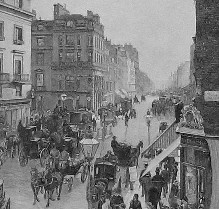
Piccadilly stretches from Piccadilly Circus in the east, to Hyde Park Corner in the West. Along the route on the north side is Burlington House, home of the Royal Academy, and on the south side Fortnum and Mason, the Ritz, St James Piccadilly, which is a Wren church, and Green Park. As well, a natural focus of the street half way along is the junction with St James Street to the south, and Albemarle Street and Old Bond Street to the north. Bond Street makes a good diversion, and so does St James Street (not described here), and perhaps through into Pall Mall, which leads to Waterloo Place.
We start from Eros in Piccadilly Circus, covered on a separate page, going along the south side. First along, very slight and only worth a glance, by Eagle Place is National and Provincial Bank, with the emblem on the corner of the building above the door consisting of a group of two cherubs holding the banner of the bank, and in their other hands, an olive branch and a palm leaf, a minor work by F. W. Pomeroy, dated 1873. These pages generally curl a lip at cherubs, putti and the like, but I include a picture anyway, as there are a variety down Piccadilly and we can make a collection. Faugh.
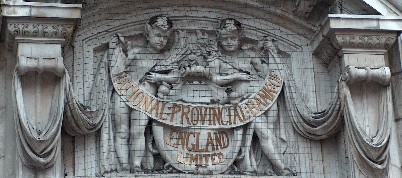 Pomeroy's National and Provincial Bank cherubs.
Pomeroy's National and Provincial Bank cherubs.
A little further, our first proper destination is St James Piccadilly, set back from the road with a small market in the yard in front.
Christopher Wren was the architect, and the church was put up in the 1670s-80s with a spire added in about 1700, some minor additions in Victorian times, and a restoration after damage in World War 2. Inside, various minor monuments, and important work by Grinling Gibbons. This website does not cover woodwork, but we should mention his work here around the altar, including extremely ornate fruit, vines, garlands and birds, and the gilded figures on the organ. More relevant to our interest, also by Gibbons is a font in white marble, showing the tree of life, with Adam and Eve, modesty preserved with a sprig of fig leaves and long hair respectively, snake, little flowers and foliage at the floor, and a baptism scene above. Wholly charming.
The monuments are wall plaques, and among various humble things we may mention:
There are various artists buried in the church, including the Willem Van de Velde, father and son, hugely important in the 17th Century as sea painters, and from our period, Robert Anning Bell, G. S. Watson, Herbert Hughes-Stanton, F W Pomeroy whose work we saw on the National and Provincial Bank, and J J Shannon. In the garden to the side of the church is an excellent example of the work of the 20th Century sculptor Alfred Hardiman, entitled Peace, being a standing Grecian girl. Also there, a fountain which forms the Viscount Southwodd Monument, including sculpture, probably in lead, of boys on dolphins.
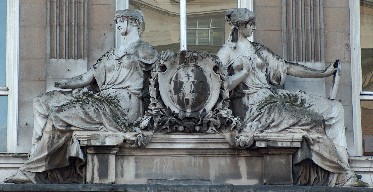 Verheyden's group on the Royal Society of Watercolour Painters.
Verheyden's group on the Royal Society of Watercolour Painters.
Continuing along the south side, we pass Fortnum and Mason, 1920s, with its sculpted arms holding torches, little heads etc, and then, on the other side, the Royal Academy at Burlington House.
Next to Fortnum and Mason on the south side we really need to cross over to the north, Academy side here to see it is the Royal Society of Painters in Watercolours, with the unadventurous Princes Arcade underneath, lofty at the front, shallow at the further end, but without serious ornament. The RSW bears portrait sculptures of famous members of the society, by Onslow Ford no less, but not particularly recognisable as by him. They represent De Wint, Cozens, David Cox, Sandby, Barret, Girtin, Turner, and William Hunt. And above the door, a substantial group of two classical maidens by Verheyden, wearing off-the-shoulder gowns, unfortunately rather losing something in their outlines from black staining on the pale stone, a little shield in between them bearing the date 1883. Already rather weathered, and one, alas, has lost a hand.
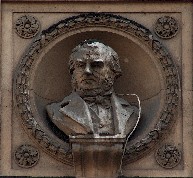 Panel from the front of the RSW, by Onslow Ford.
Panel from the front of the RSW, by Onslow Ford.
Burlington House has a separate page, but we note here the front archway facing on to Piccadilly. It has four spandrel groups, two inside, two outside, each showing an elegant emblematic girl, accompanied by one or more cherubs. Good work, which I believe to be by the excellent and prolific Birnie Philip. On the outside, to the left, perhaps Literature, holding a scroll and book, a swan behind could this be rather a Leda and the swan? it would be in the sense of her engendering of beauty (Helen of Troy) - for more on Leda, and swan sculpture generally, see this page. The right hand spandrel is clearer she is clearly emblematic of the Sciences, holding a telescope and set square, her cherub looking at a globe, a snake behind her other shoulder, symbol of medicine.
On the interior of the gate, the left hand figure, the most beautiful of the four, has her back to us for compositional reasons, and looks at us over her shoulder. She is some creature of the heavens, having a foot on the moon, and being accompanied as well as by her two cherubs, a further winged figure with a butterfly on her head, and a winged globe. A hatching egg and a pepper may also be spotted by the sharp sighted. Perhaps Heavenly Inspiration? Finally, the fourth figure is most clear as the Arts the girl herself holds nothing, but looks at the image of a nude on a shield held by a cherub with a sculptor s mallet, resting on top of a pillar (architecture); the other cherub has palette and musical instruments, and a large decorated pot. All in the best possible taste.
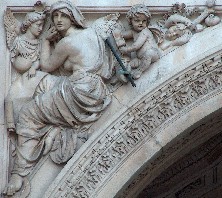 Spandrel group, Burlington House.
Spandrel group, Burlington House.
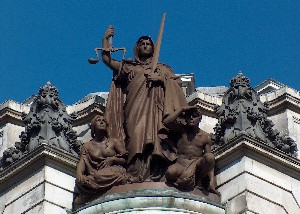 Justice et al, by Herbert Binney, Norwich Union building
Justice et al, by Herbert Binney, Norwich Union building
Back in Piccadilly we might note that more or less opposite Old Bond Street was the Egyptian Hall, which housed a series of museum exhibitions - happily the statues of Isis and Osiris from this building survive - see this page. Turning right, the next junction is with Albemarle Street, and on the south side, St James Street. This is a centrepiece of the street, and the best view is still from the North side, after having crossed over Albemarle St. On the western corner of St James Street with Piccadilly is a tall tiled building which was built as the Royal Insurance Company's branch office in the West End. The architect was John Belcher, and little expense was spared on this valuable site, with Pentelikon marble for the facades, and bronze detailing and dormer roofs, and art metalwork by J. W. Singer and Sons. The sculptural decoration consists of identical pairs of cherubs high up at third floor level, by the sculptor Bertram Mackennal, and over the corner doorway, a plaque by Albert Drury, a small thing of two cherubs next to a baroque shield depicting a heron or similar water bird.
On the eastern corner of St James Street and Piccadilly is the Norwich Union building, with an important sculptural group by Hibbert Binney. The centrepiece is of course Justice, carrying her scales and unsheathed sword. She is heavily draped, while the girl at her feet on the left has an off-the shoulder garment that still manages a heaviness, and the young man on the right is unclad but for a strategically draped cloth. The girl holds corn, and the man looks into the future - thus as a couple, they are concerned with the long term and save, reaping the corn they have sown bit by bit appropriate allegory for an insurance society. The building also bears three pairs of cherubs in stone at 3rd floor height.
Crossing over, and looking back to the north side, the carpet shop on the corner with Albemarle Street, a Doulton terra cotta effort in Renaissance style, can be seen to have terra cotta medallions showing religious and mythological portraits - apparently taken from coins in the British Museum. It dates from 1887/8, was built as the Albemarle Hotel, and the architects were George and Peto.
Going under the arches of the Ritz brings us to the north side of St James Park, Green Park, and the tube station. The south exit of the tube station leads to the Diana Fountain, described here. There are however three more things sculptural to see along Piccadilly itself. Firstly, a hundred yards or so along, is a complex ironwork gate. This was built for a great house in Turnham Green in the early 18th Century, then in the 19th Century moved first to Chiswick House and then Devonshire House, William Kent's great mansion for the Dukes of Devonshire which stood in Piccadilly, and then to its current position in about 1921 when Devonshire House was pulled down. At the time, the Ministry of Works was able to reassure that no trees in the Park would be cut down, only 10 square feet would be taken from the Park's area, and the cost would be met from Victoria Memorial left over funds rather than needing new public funding. The sphinxes at each end of the gate, then, would be 18th Century. Strange things, with leonine naturalistic slender bodies, long necks, European rather than remotely Egyptian female heads, and headdresses trailing forward over the breasts. Oddly, the front paws overlap the edge of their supporting bases, leaving them hanging and suggesting they were made for some other setting. All this has the feel of the sculptor Henry Cheere, though I have not been able to find any references suggesting this.
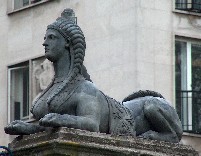 Sphinx on the Green Park gates.
Sphinx on the Green Park gates.
Opposite, we may note the entrance to Half Moon Street, with some 1960s or 70s hideosity on the corner, bearing four sculptured panels, showing from bottom, Diana the Huntress, minstrel in harlequin with stringed instrument, Mercury with boat, and an owl among trees, whimsical and na ve a certain Keith Godwin was apparently the sculptor.
Finally, 50 yards further to west, beyond White Horse St, is nos 101-4, now the Japanese Embassy a tall block of 3 bays, each with a pair of allegorical girls in the spandrels at first floor level, more minor decoration higher up. Among the girls, one pair probably represent the Arts, with easel, small statue of an angel holding a ball; the Empire, holding a portrait of Victoria, and a Britannia with trident, Union Jack, helm and nice mailshirt the latter most emblematic, with trident, lighthouse and ship behind, acorn leaves. The third pair, semidraped figures symbolic of Europe and Asia. Europe, with castellated crown, sword hilt as a cross, a staff, olive branch and horned cow behind; Asia, holding a lamp, wearing exotic necklace and arm arms, and elepant and the leaves of perhaps a breadfruit tree behind. The next pair are Africa, another exotic maiden with tasselled jewellery, a fan, a broken chain, date palm and camel behind. And Australia, classical face, complex hair arrangement, cradling a gun and a sheep. Various portraits in profile, including perhaps Canada with a beaver, an owl; highest of all, little cherubs and grotesque lions.
And there ends the walk. One can go back to Green Park tube, and southwards across the park to Buckingham Palace and the Victoria Memorial, or onward to the end of the park, to Hyde Park Corner and Constitution Arch.
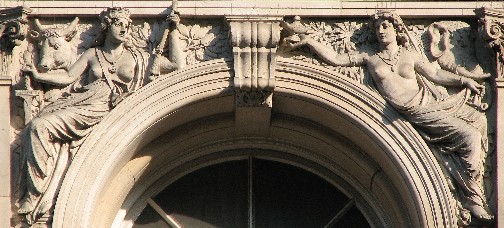 Spandrel girls from 101-4 Piccadilly
Spandrel girls from 101-4 Piccadilly
Burlington House (North side Piccadilly) // East to Piccadilly Circus // West to Hyde Park Corner
South to the Diana the Huntress statue // and thence to the Victoria Memorial by Buckingham Palace
North along Berkeley Street to Berkeley Square and Mount Street
London sculpture // Sculpture pages
Visits to this page from 23 Nov 2011: 12,025